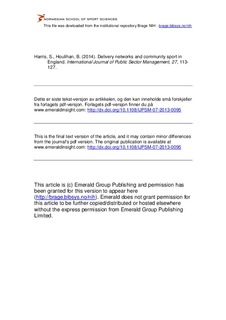| dc.contributor.author | Harris, Spencer | |
| dc.contributor.author | Houlihan, Barrie | |
| dc.date.accessioned | 2014-05-23T07:53:51Z | |
| dc.date.available | 2014-05-23T07:53:51Z | |
| dc.date.issued | 2014 | |
| dc.identifier.citation | International Journal of Public Sector Management. 2014, 27, 113-127 | nb_NO |
| dc.identifier.uri | http://hdl.handle.net/11250/195343 | |
| dc.description | I Brage finner du siste tekst-versjon av artikkelen, og den kan inneholde ubetydelige forskjeller fra forlagets pdf-versjon. Forlagets pdf-versjon finner du på www.emeraldinsight.com: http://dx.doi.org/10.1108/IJPSM-07-2013-0095 / In Brage you'll find the final text version of the article, and it may contain insignificant differences from the journal's pdf version. The definitive version is available at www.emeraldinsight.com: http://dx.doi.org/10.1108/IJPSM-07-2013-0095 | nb_NO |
| dc.description.abstract | Purpose – The paper aims to utilise Adam and Kriesi's network approach to policy analysis to examine the range of exogenous factors that affect interactions in the community sport policy process from a local authority perspective.
Design/methodology/approach – The research is based upon two case studies. Each case study involved semi-structured interviews with three local authority middle/senior managers, three senior County Sport Partnership (CSP) representatives, and eight regional/county national governing bodies of sport (NGB) representatives.
Findings – While the two cases exhibit distinctive socio-economic and structural profiles they provide valuable evidence regarding the operation of the network of partners involved in community sport and also illustrate the utility of Adam and Kriesi's analytical framework. In relation to Adam and Kriesi's power/interaction model both cases illustrate the fragmentation of power at the community level although interaction in one case exhibits a pattern best characterised as “competition” whereas interaction in the other is more closely associated with “horizontal cooperation”.
Research limitations/implications – The paper highlights the need for improved theorisation of partnership arrangements in community sport, in particular: examining the relationship between issues such as resources, organisational capacity, and traditional involvement in sport development and attitudes toward the community sport policy process; linked to this, mapping the causal relationships in partnerships, i.e. what factors lead to what actions or behaviours; and investigating the utility of various strategies in developing a more cohesive and effective sub-regional policy system.
Originality/value – Local authority perspectives of community sport policy is an under-researched topic. It is timely to study these perspectives due to the refreshed community sport policy for 2013-2017, the traditional status of local government as the major funder of community sport, and the public sector budget reductions and reported implications for non-statutory services, such as community sport | nb_NO |
| dc.language.iso | eng | nb_NO |
| dc.publisher | Emerald Insight | nb_NO |
| dc.subject | VDP::Samfunnsvitenskap: 200::Statsvitenskap og organisasjonsteori: 240 | nb_NO |
| dc.subject | public sector | |
| dc.subject | policy | |
| dc.subject | England | |
| dc.subject | local government | |
| dc.subject | community sport | |
| dc.subject | policy networks | |
| dc.title | Delivery networks and community sport in England | nb_NO |
| dc.type | Journal article | nb_NO |
| dc.type | Peer reviewed | nb_NO |
| dc.source.journal | International Journal of Public Sector Management | nb_NO |
| dc.identifier.doi | 10.1108/IJPSM-07-2013-0095 | |
| dc.description.localcode | Seksjon for kultur og samfunn / Department of Cultural and Social Studies | nb_NO |
